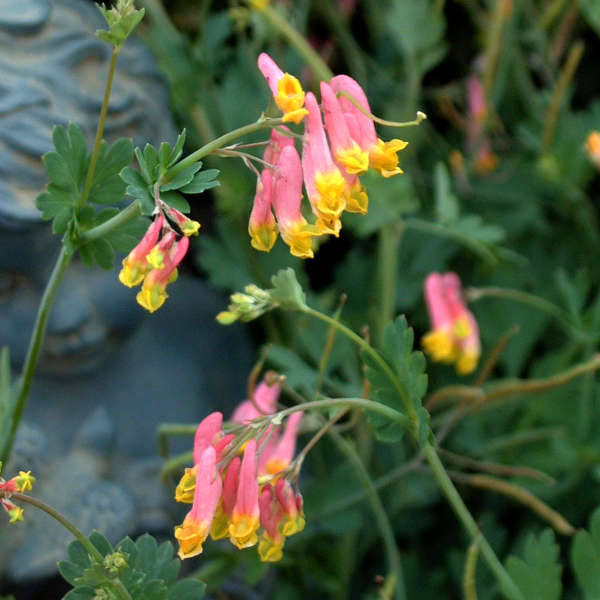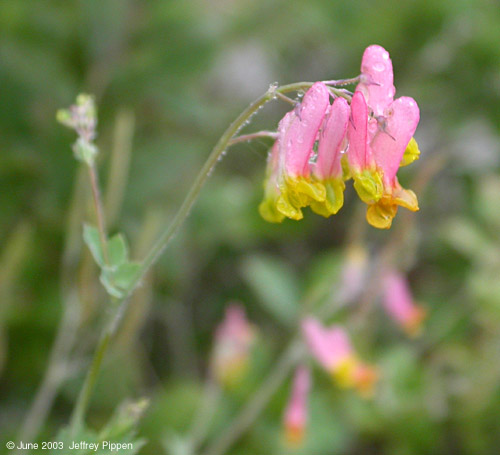Rock Harlequin: Letting Nature Take the Lead
Instead of featuring a Wildflower that’s currently blooming, let’s talk about one that used to bloom here in Cuyahoga Valley National Park: Rock Harlequin, or Capnoides sempervirens (or Corydalis sempervirens). The more I learn about this intriguing wildflower, the more I hope to see it in person one day.




Photo Credits: Perennial Resource, Jeffrey Pippen, Karen, courtesy of The National Gardening Association’s Plant Database, and WiseAcre, courtesy of WiseAcre Gardens.
This pink and yellow bloom is unmistakable, and those leaves look awfully familiar! Do they remind you of Dutchman’s breeches? Squirrel corn? Perhaps faintly of Greater celandine? Well, good eye! These four plants belong to the Poppy family, Papaveraceae.
Rock Harlequin is a pioneer species, so it’ll swoop into disturbed areas, but doesn’t persist very long as the habitat grows back. Furthermore, it’s defined as a pioneer species for secondary succession. Secondary succession occurs when a pre-existing habitat experiences a disturbance that greatly affects the plant population but doesn’t destroy everything (this is opposed to primary succession, which occurs on bare rock where plant life was not occurring before). Additionally, Rock Harlequin prefers to pioneer areas disturbed by fire.
Though this bloom can be picky, Rock Harlequin doesn’t always have its way. In the absence of recent fires, we might simply find this bloom on rocky, well-drained slopes in areas of partial to full sunlight. In comes a CVNP favorite: The Virginia Kendall Ledges. We’ve got some nice rocky, well-drained slopes there, yea?
Photo credit: NPS
Well, sorry to get your hopes up, but Rock Harlequin not as common as it used to be at our Lovely Ledges. Our Ledges have been bouncing back from prior years of use for hunting recreation, farming, and even as living places by Native Americans. So, The Ledges is no stranger to pioneer species. However, as a beloved attraction of CVNP, The Ledges are taking on a new force of impact: the footsteps of excited park visitors like you and me.
What does this mean for the Rock Harlequin? As The Ledges began to bounce back from former use, pioneer species survived comfortably. However, as a perennial that, for part of its life, exists as a low-lying herbaceous plant, the Rock Harlequin has not withstood the forces that accompany the love and appreciation of park visitors. In short, the Rock Harlequin is now a rare find amongst The Ledges.
And let me be clear: I am not discouraging anybody from visiting The Ledges and nobody should feel bad for wanting to visit either! This land is here for all of us to enjoy! However, if we want to continue enjoying it for generations to come, we have a duty to enjoy it responsibly. We can do this together by being mindful of the current traffic to the resource, staying on the trail, and being mindful of our impact on trail conditions after rain events.
However, there is still hope for the lovely Rock Harlequin! Rock Harlequin produces VERY hardy seeds that can survive in the seed bank for decades and even centuries. So, although we do not see Rock Harlequin today at The Ledges, we could see it there in the future. Nature is more than capable of paving its own course, and we simply must support that. Perhaps if our current circumstances change and The Ledges catch a break, we’ll see this beautiful bloom resurface and thrive. What do you think?
Here are some helpful resources if you would like to learn more about Rock Harlequin:
https://writingfornature.wordpress.com/tag/capnoides-sempervirens/
https://www.fs.fed.us/database/feis/plants/forb/corsem/all.html



Comments
Add a Comment